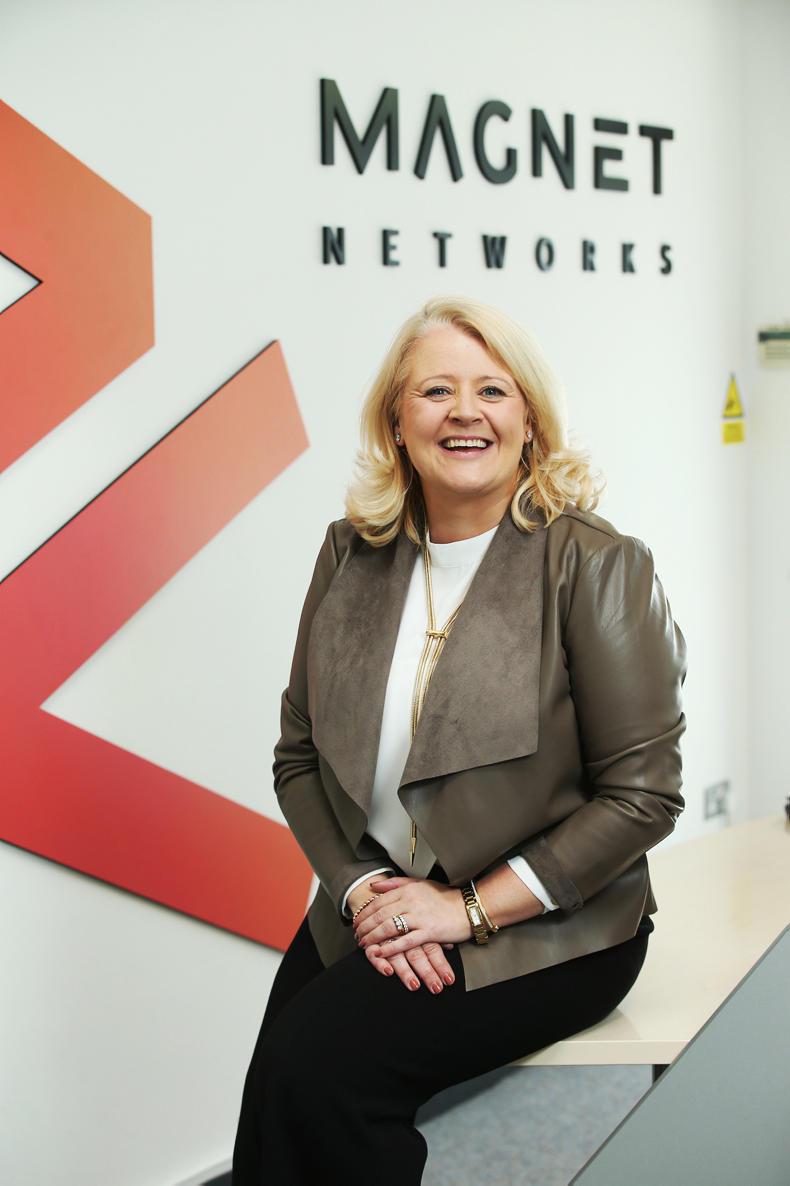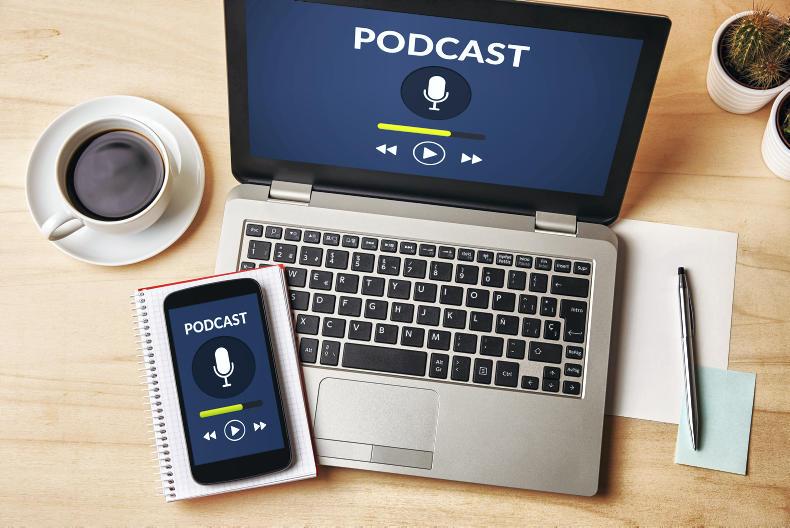If you suffer from problems with broadband internet, you’re not alone. The results of Irish Country Living’s recent broadband survey reveal that 71% of respondents have a connectivity speed of less than 10 megabits per second (Mbps), which is only suitable for causal internet use, such as checking emails and visiting websites.
With children attempting to complete online schoolwork and parents now working from home, connectivity issues are being reported at a steady rate throughout rural Ireland.
Noel Clancy is a suckler and sheep farmer from Drangan, Co Tipperary. He experiences regular problems with his broadband and mobile phone coverage (proof of this came when our phone conversation was cut prematurely short).

Noel Clancy is a suckler and sheep farmer from Drangan, Co Tipperary. \ Ramona Farrelly
“Sometimes it’s not too bad, but you couldn’t download a big file or anything,” he says.
“Now that the kids are home from school it’s nearly impossible to do anything. The school apps [where they receive assignments] have been very slow and, since the lockdown, it’s getting worse with most people trying to work from home.”
Twenty four per cent of respondents to the Irish Country Living broadband survey say that they are unable to work from home as a result of their internet issues.
A lot of the farmers can’t upload videos when they’re curating the account
A further 43% said they could “just about” work from home. Noel, who runs the Ireland’s Farmers (@IrelandsFarmers) Twitter account – which boasts a following of 30,000 – says the job puts him in touch with farmers throughout the country who report similar problems.
“A lot of the farmers can’t upload videos when they’re curating the account,” he explains.
“Different farmers take it on each week and many have [connectivity] issues. I just wonder, over the next few years with the COVID-19 crisis ongoing, will the money even be there for the government to work on these broadband problems?”
Martin Ryan operates Orion Broadband in Templemore, Co Tipperary. He says his customers are experiencing a range of issues since lockdown began, and while there are many solutions available, some things will always stand in the way of achieving good connectivity. For fibre broadband, internet speed depends on how far data travels from fibre cables – the further you live from one of these cables; the worse your internet speed will be.
“It’s hit and miss,” he says. “We’ve been able to avail of Eir’s fibre cables, so the transfer distances might be a kilometre, more or less – that’s an achievable distance limit. Mountainous areas are problematic because you need to power remote sites.”
Martin also says that many rural homes have not been designed with broadband in mind. For example, a concrete roof can cause connectivity issues.
He recommends purchasing home plugs, (available online, from €25) and ethernet cables (also available online, from €5) that can help secure your home connection for remote working.
You can also connect these cables to your smart TV if you’ve been having difficulty streaming Netflix or other applications.
As more demand comes in we’re having to change the technology
“What we call ‘backhaul’ is like a big pipe [of broadband] that comes from Dublin, and that’s what’s struggling,” he explains. “As more demand comes in we’re having to change the technology.”
“Contention ratio” is a term regularly touted when researching broadband packages. Irish Country Living asked Louise McKeown, marketing director of Dublin-based Magnet Networks, what this term means and how it can affect the speed and connectivity of rural broadband.

Louise McKeown, marketing director of Magnet Networks.
“If you’ve have a speed test done [in your home] and the speed is 100Mbps, this is your speed before the contention ratio comes in,” she explains.
“If your contention ratio is 24:1, it means your speed is 100Mbps, but only when you alone are using the service. If the other 24 people are on at the same time, your speed will be affected.”
Louise says that Magnet Networks has tested potential internet speed around the country and most areas have a capability of at least 20Mbps – or, up to three times what many users are currently experiencing. Since Magnet Networks don’t use contention ratios; they tell clients that their ratio is always 1:1.
“You have 100Mbps capability? That’s the speed you’ll always have, with us,” she states.
We have a client from a very remote location and, before lockdown, he was able to survive on 2Mbps
Louise says that their Broadband Anywhere service has worked well in some of Ireland’s most poorly affected broadband regions.
“We have a client from a very remote location and, before lockdown, he was able to survive on 2Mbps,” she says. “Once lockdown began, it just wasn’t suited. Recently, he sent us a video of a speed test that showed he is now getting 82Mbps. This now gives him the ability to choose to work from home, post-lockdown, as a business operator.”
This service, like any other, depends on the speed capabilities of your region. If your home is speed tested and the results are less than 10Mbps, you will likely still experience slow broadband.
With more people using broadband to work and keep in touch with loved ones, Magnet Networks have launched a service called Virtual Support, which aims to help anyone with general IT issues.
The phone service costs €25 per 25-minute session and claims to resolve 97% of problems per call.
“We have been approached with a lot of questions that actually have nothing to do with the broadband,” she explains.
“It would be a problem with zoom or a camera or another application. We’re just helping people who need general support at home.”
Broadband: a high-capacity internet transmission that allows for multiple applications to be used at once.Mbps: Megabits per second measures upload and download speeds.Connectivity: a term used to describe internet capacity or ability.Fibre broadband: a type of high-speed broadband that uses fibre optic cables to transfer data. Data: Computer operations are performed using data, which are often transmitted by electrical signals.Ethernet: A system for connecting a number of computer systems to form a local network. Home plug: A power line network designed to run ethernet through an existing electrical system, for those experiencing broadband problems.Contention ratio: The maximum demand on your broadband connection. If everyone included in your contention ratio is using the internet at the same time, it could affect your connectivity and speed.
If you suffer from problems with broadband internet, you’re not alone. The results of Irish Country Living’s recent broadband survey reveal that 71% of respondents have a connectivity speed of less than 10 megabits per second (Mbps), which is only suitable for causal internet use, such as checking emails and visiting websites.
With children attempting to complete online schoolwork and parents now working from home, connectivity issues are being reported at a steady rate throughout rural Ireland.
Noel Clancy is a suckler and sheep farmer from Drangan, Co Tipperary. He experiences regular problems with his broadband and mobile phone coverage (proof of this came when our phone conversation was cut prematurely short).

Noel Clancy is a suckler and sheep farmer from Drangan, Co Tipperary. \ Ramona Farrelly
“Sometimes it’s not too bad, but you couldn’t download a big file or anything,” he says.
“Now that the kids are home from school it’s nearly impossible to do anything. The school apps [where they receive assignments] have been very slow and, since the lockdown, it’s getting worse with most people trying to work from home.”
Twenty four per cent of respondents to the Irish Country Living broadband survey say that they are unable to work from home as a result of their internet issues.
A lot of the farmers can’t upload videos when they’re curating the account
A further 43% said they could “just about” work from home. Noel, who runs the Ireland’s Farmers (@IrelandsFarmers) Twitter account – which boasts a following of 30,000 – says the job puts him in touch with farmers throughout the country who report similar problems.
“A lot of the farmers can’t upload videos when they’re curating the account,” he explains.
“Different farmers take it on each week and many have [connectivity] issues. I just wonder, over the next few years with the COVID-19 crisis ongoing, will the money even be there for the government to work on these broadband problems?”
Martin Ryan operates Orion Broadband in Templemore, Co Tipperary. He says his customers are experiencing a range of issues since lockdown began, and while there are many solutions available, some things will always stand in the way of achieving good connectivity. For fibre broadband, internet speed depends on how far data travels from fibre cables – the further you live from one of these cables; the worse your internet speed will be.
“It’s hit and miss,” he says. “We’ve been able to avail of Eir’s fibre cables, so the transfer distances might be a kilometre, more or less – that’s an achievable distance limit. Mountainous areas are problematic because you need to power remote sites.”
Martin also says that many rural homes have not been designed with broadband in mind. For example, a concrete roof can cause connectivity issues.
He recommends purchasing home plugs, (available online, from €25) and ethernet cables (also available online, from €5) that can help secure your home connection for remote working.
You can also connect these cables to your smart TV if you’ve been having difficulty streaming Netflix or other applications.
As more demand comes in we’re having to change the technology
“What we call ‘backhaul’ is like a big pipe [of broadband] that comes from Dublin, and that’s what’s struggling,” he explains. “As more demand comes in we’re having to change the technology.”
“Contention ratio” is a term regularly touted when researching broadband packages. Irish Country Living asked Louise McKeown, marketing director of Dublin-based Magnet Networks, what this term means and how it can affect the speed and connectivity of rural broadband.

Louise McKeown, marketing director of Magnet Networks.
“If you’ve have a speed test done [in your home] and the speed is 100Mbps, this is your speed before the contention ratio comes in,” she explains.
“If your contention ratio is 24:1, it means your speed is 100Mbps, but only when you alone are using the service. If the other 24 people are on at the same time, your speed will be affected.”
Louise says that Magnet Networks has tested potential internet speed around the country and most areas have a capability of at least 20Mbps – or, up to three times what many users are currently experiencing. Since Magnet Networks don’t use contention ratios; they tell clients that their ratio is always 1:1.
“You have 100Mbps capability? That’s the speed you’ll always have, with us,” she states.
We have a client from a very remote location and, before lockdown, he was able to survive on 2Mbps
Louise says that their Broadband Anywhere service has worked well in some of Ireland’s most poorly affected broadband regions.
“We have a client from a very remote location and, before lockdown, he was able to survive on 2Mbps,” she says. “Once lockdown began, it just wasn’t suited. Recently, he sent us a video of a speed test that showed he is now getting 82Mbps. This now gives him the ability to choose to work from home, post-lockdown, as a business operator.”
This service, like any other, depends on the speed capabilities of your region. If your home is speed tested and the results are less than 10Mbps, you will likely still experience slow broadband.
With more people using broadband to work and keep in touch with loved ones, Magnet Networks have launched a service called Virtual Support, which aims to help anyone with general IT issues.
The phone service costs €25 per 25-minute session and claims to resolve 97% of problems per call.
“We have been approached with a lot of questions that actually have nothing to do with the broadband,” she explains.
“It would be a problem with zoom or a camera or another application. We’re just helping people who need general support at home.”
Broadband: a high-capacity internet transmission that allows for multiple applications to be used at once.Mbps: Megabits per second measures upload and download speeds.Connectivity: a term used to describe internet capacity or ability.Fibre broadband: a type of high-speed broadband that uses fibre optic cables to transfer data. Data: Computer operations are performed using data, which are often transmitted by electrical signals.Ethernet: A system for connecting a number of computer systems to form a local network. Home plug: A power line network designed to run ethernet through an existing electrical system, for those experiencing broadband problems.Contention ratio: The maximum demand on your broadband connection. If everyone included in your contention ratio is using the internet at the same time, it could affect your connectivity and speed. 










SHARING OPTIONS